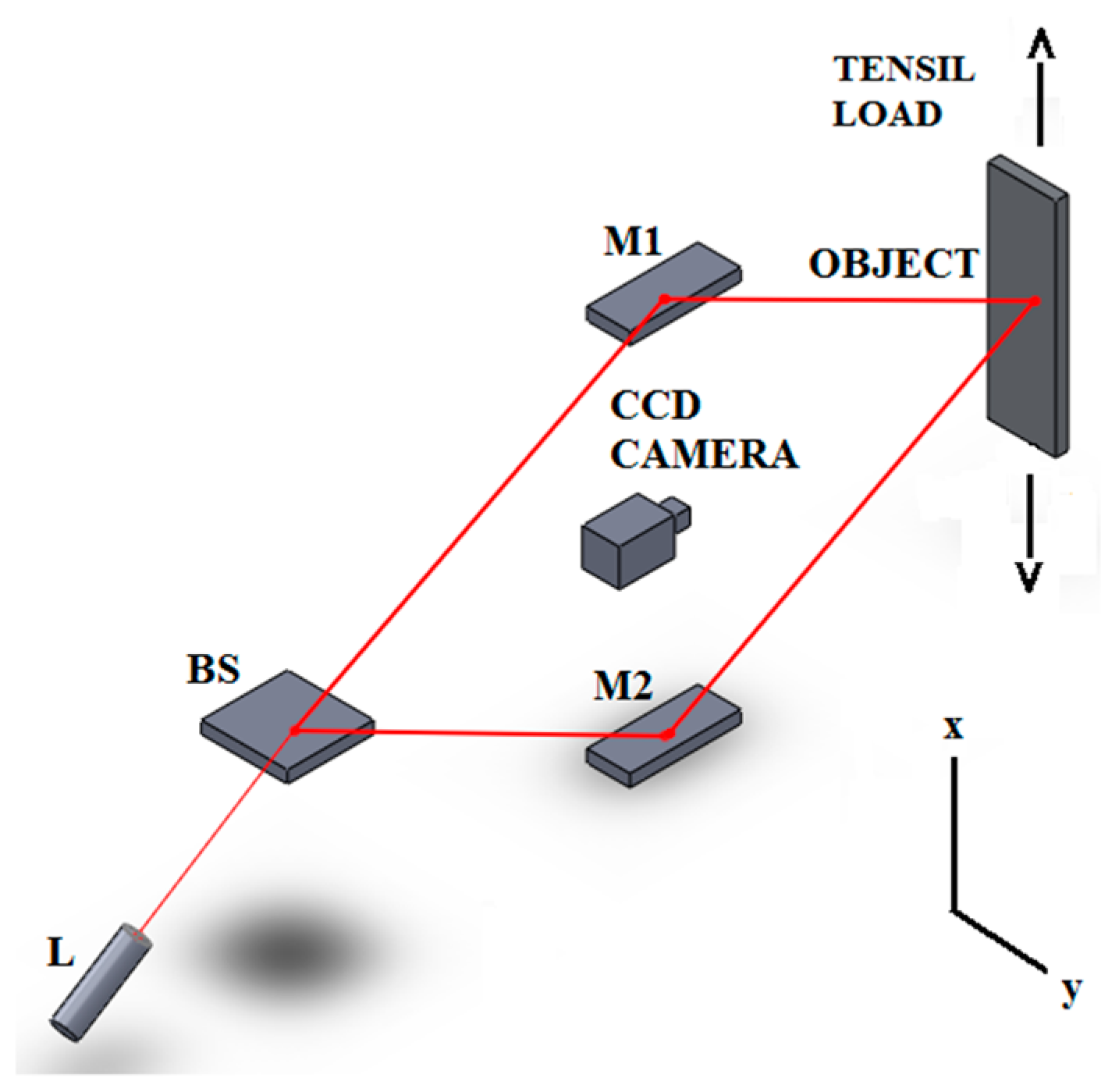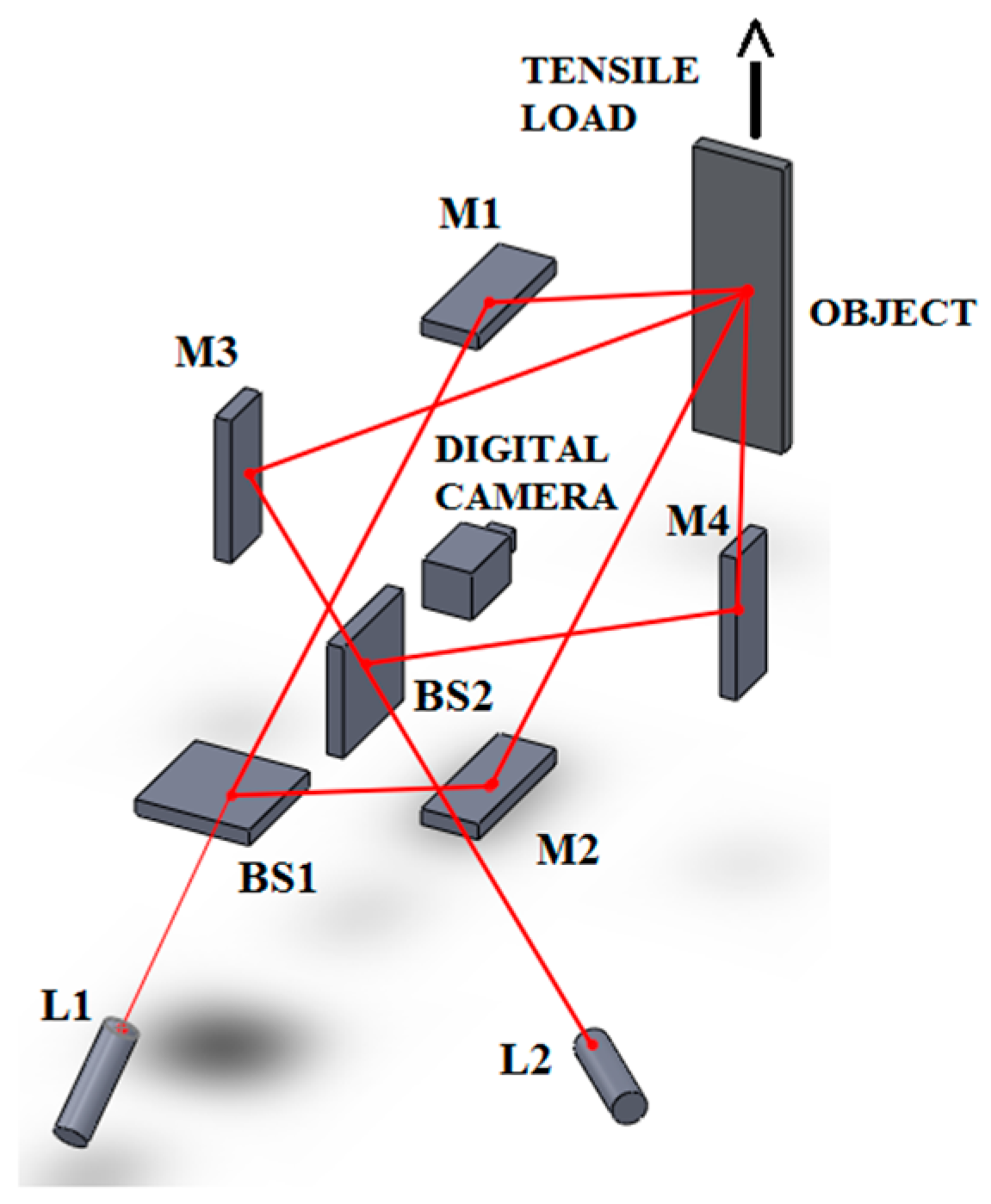Application of Electronic Speckle Pattern Interferometry Method for Simultaneous Measurement of Young’s Modulus and the Poisson’s Ratio of Metals †
Abstract
:1. Introduction
2. Materials and Methods
3. Experimental Details
4. Result and Discussion
5. Conclusions
Author Contributions
Conflicts of Interest
References
- Jacquot, P. Speckle Interferometry: A Review of the Principal Methods in Use for Experimental Mechanics Applications. Strain 2008, 44, 57–69. [Google Scholar] [CrossRef]
- Mohan, K.; Rastogi, P. Recent developments in digital speckle pattern interferometry. Opt. Lasers Eng. 2003, 40, 439–445. [Google Scholar] [CrossRef]
- Sirohi, R.S. Optical Methods of Measurement, Wholefield Techniques, 2nd ed.; CRC Press: New York, NY, USA, 2009; pp. 149–191. [Google Scholar]
- Vannoni, M.; Molesini, G. Speckle interferometry experiments with a digital photocamera. Am. J. Phys. 2004, 72, 906–909. [Google Scholar] [CrossRef]
- Vannoni, M.; Molesini, G. In-plane, out-of-plane and time-average speckle interferometry experiments with a digital photocamera. In Proceedings of the Photonic Engineering Opto-Ireland, Dublin, Ireland, 4–6 April 2005; Volume 5827, pp. 617–626. [Google Scholar]
- Vannoni, M.; Trivi, M.; Arizaga, R.; Rabal, H.; Molesini, G. Dynamic speckle imaging with low-cost devices. Eur. J. Phys. 2008, 29, 967–975. [Google Scholar] [CrossRef]
- Monowar, A.K.; Kawazoe, M. Electronic Speckle pattern interferometry using compressed images from a digital still camera. Opt. Eng. 1998, 37, 1599–1601. [Google Scholar]
- Moore, A.J. An electronic speckle pattern interferometer for complete in-plane displacement measurement. Meas. Sci. Technol. 1996, 1, 1024–1030. [Google Scholar] [CrossRef]
- Fan, H.; Wang, J.; Tan, Y.H. Simultaneous measurement of whole in-plane displacement using phase-shifting ESPI. Opt. Lasers Eng. 1997, 28, 249–257. [Google Scholar] [CrossRef]
- Martinez, A.; Rayas, J.A. Simultaneous measurement with one-capture of the two in-plane components of displacement by electronic speckle pattern interferometry. Opt. Commun. 2008, 281, 4291–4296. [Google Scholar] [CrossRef]
- Parra-Michel, J.; Martinez, A.; Rayas, J.A. Computation of rack tip elastic stress intensity factor in mode I by in-plane electronic speckle pattern interferometry. Revista Mexicana de Física 2010, 56, 394–400. [Google Scholar]
- Boresi, A.P.; Schmidt, R.J. Advanced Mechanics of Materials, 5th ed.; Wiley: New York, NY, USA, 1992. [Google Scholar]
- Leendertz, J.A. Interferometric displacement measurement on scattering surfaces utilizing speckle effect. J. Phys. E 1970, 3, 214–218. [Google Scholar] [CrossRef]
- ImageJ. An open platform for scientific image analysis. Available online: http://imagej.net (accessed on 16 July 2018).



| Load (kgf) | Aluminium | Copper | Brass | |||
|---|---|---|---|---|---|---|
| Axial | Transversal | Axial | Transversal | Axial | Transversal | |
| 5 | 6.23 | 7.5 | 4.8 | 4.9 | 3.67 | 4.5 |
| 10 | 11.55 | 13.5 | 8.2 | 8.8 | 7.37 | 8.6 |
| 15 | 16.36 | 20.5 | 12 | 13 | 10.85 | 12.9 |
| 20 | 20.96 | 27.5 | 15 | 17.5 | 13.97 | 16.9 |
| Load (kgf) | Displacement (μm) | |||||
|---|---|---|---|---|---|---|
| Aluminium | Copper | Brass | ||||
| Axial | Transversal | Axial | Transversal | Axial | Transversal | |
| 5 | 3.7 | 3.3 | 2.2 | 2.1 | 2.2 | 1.9 |
| 10 | 6.9 | 5.9 | 4.4 | 3.8 | 4.4 | 3.7 |
| 15 | 9.8 | 9.0 | 6.5 | 5.7 | 6.5 | 5.6 |
| 20 | 12.6 | 12.1 | 8.3 | 7.7 | 8.3 | 7.4 |
| Material | Calculated Young’s Modulus (GPa) | Young’s Modulus from Reference (GPa) | The Difference (%) |
|---|---|---|---|
| Aluminium | 70.28 | 71.70 | 2.0 |
| Copper | 104.80 | 110 | 4.70 |
| Brass | 111.58 | 110.30 | 1.16 |
| Material | Calculated Poisson’s Ratio | Poisson’s Ratio from Reference | Difference (%) |
|---|---|---|---|
| Aluminum | 0.33 | 0.33 | 0 |
| Copper | 0.34 | 0.35 | 2.8 |
| Brass | 0.33 | 0.35 | 5.7 |
Publisher’s Note: MDPI stays neutral with regard to jurisdictional claims in published maps and institutional affiliations. |
© 2018 by the authors. Licensee MDPI, Basel, Switzerland. This article is an open access article distributed under the terms and conditions of the Creative Commons Attribution (CC BY) license (https://creativecommons.org/licenses/by/4.0/).
Share and Cite
Michtchenko, A. Application of Electronic Speckle Pattern Interferometry Method for Simultaneous Measurement of Young’s Modulus and the Poisson’s Ratio of Metals. Proceedings 2018, 2, 521. https://doi.org/10.3390/ICEM18-05396
Michtchenko A. Application of Electronic Speckle Pattern Interferometry Method for Simultaneous Measurement of Young’s Modulus and the Poisson’s Ratio of Metals. Proceedings. 2018; 2(8):521. https://doi.org/10.3390/ICEM18-05396
Chicago/Turabian StyleMichtchenko, Alexandre. 2018. "Application of Electronic Speckle Pattern Interferometry Method for Simultaneous Measurement of Young’s Modulus and the Poisson’s Ratio of Metals" Proceedings 2, no. 8: 521. https://doi.org/10.3390/ICEM18-05396
APA StyleMichtchenko, A. (2018). Application of Electronic Speckle Pattern Interferometry Method for Simultaneous Measurement of Young’s Modulus and the Poisson’s Ratio of Metals. Proceedings, 2(8), 521. https://doi.org/10.3390/ICEM18-05396




